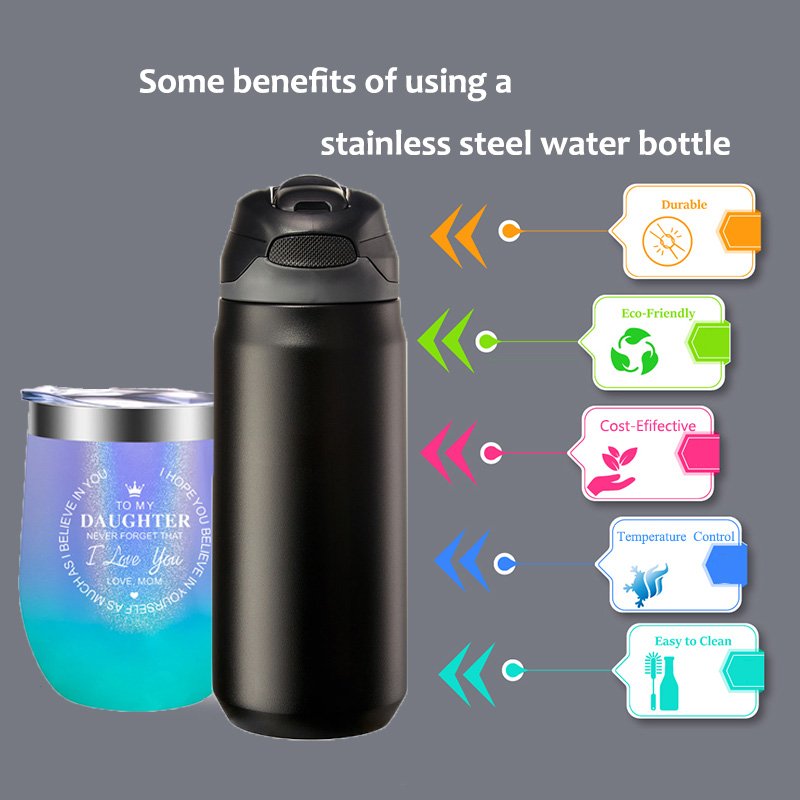Understanding Vacuum Insulated Stainless Steel: A Comprehensive Guide
Introduction to Vacuum Insulated Stainless Steel
Vacuum insulated stainless steel represents a significant advancement in material science, offering superior thermal insulation properties. This technology is widely recognized for its ability to maintain the temperature of contents for extended periods, whether keeping liquids hot or cold. The core principle behind vacuum insulation lies in creating a vacuum between two stainless steel walls. This vacuum acts as a barrier to heat transfer, effectively minimizing the conduction and convection processes that typically occur.
Unlike traditional insulation methods, which rely on foam or other insulating materials, vacuum insulation leverages the absence of air or other gases to impede thermal energy movement. This results in enhanced temperature retention, making vacuum insulated stainless steel an ideal choice for applications requiring stringent temperature control. Common uses include thermos flasks, travel mugs, and various types of food storage containers, where maintaining the temperature of contents is crucial.
The history and development of vacuum insulated technology dates back to the late 19th century, with the invention of the vacuum flask by Sir James Dewar. This pioneering concept has evolved over the decades, incorporating advancements in stainless steel manufacturing and vacuum sealing techniques. Today, the integration of vacuum insulation into stainless steel products has expanded its utility across multiple industries, including healthcare, food and beverage, and outdoor recreation.
Understanding vacuum insulated stainless steel provides a foundation for appreciating its numerous benefits and diverse applications. This guide aims to explore the nuances of this technology, offering insights into its construction, performance, and the advantages it holds over conventional insulation methods. As we delve deeper, it becomes evident how this sophisticated material continues to shape our daily lives through its innovative and practical applications.
How Vacuum Insulated Stainless Steel Works
Vacuum insulated stainless steel technology represents a significant advancement in thermal insulation. At its core, this technology relies on the principle of creating a vacuum between two layers of stainless steel, thereby minimizing heat transfer. This section examines the intricate mechanics behind this innovation and elucidates key terms such as thermal conductivity, vacuum, and insulation efficiency.
Thermal conductivity refers to a material’s ability to conduct heat. Stainless steel, by itself, has moderate thermal conductivity, meaning it can transfer heat relatively efficiently. However, when a vacuum is introduced between two stainless steel layers, the scenario changes dramatically. A vacuum is essentially a space devoid of matter, including air, which is a common medium for heat transfer. By eliminating the air, the vacuum acts as a formidable barrier against heat flow.
In a typical vacuum insulated stainless steel container, two stainless steel walls are separated by a vacuum. This vacuum significantly reduces conduction and convection, the two primary modes of heat transfer. Conduction is the transfer of heat through a material, while convection is the transfer of heat through fluids (liquids or gases). Without matter in the vacuum to facilitate these processes, heat transfer is drastically minimized, maintaining the temperature of the contents inside the container for extended periods.
Insulation efficiency is a measure of how well a system prevents heat transfer. In vacuum insulated stainless steel products, this efficiency is exceptionally high. The inner layer, in contact with the contents, retains its temperature, while the outer layer remains unaffected by external temperature fluctuations, thanks to the vacuum barrier. This dual-layer system ensures that hot contents stay hot and cold contents stay cold for hours on end.
Visual aids such as diagrams can significantly enhance the understanding of this technology. These diagrams typically illustrate the structural components of vacuum insulated containers, highlighting the dual stainless steel walls and the intervening vacuum. By examining these illustrations, one can better appreciate how the vacuum serves as a powerful insulator.
Benefits of Vacuum Insulated Stainless Steel
Vacuum insulated stainless steel has revolutionized the way we store beverages and food, delivering a plethora of advantages that make it the material of choice for many consumers. One of the most notable benefits is its superior temperature retention. Whether you need to keep your coffee hot during a long commute or your water chilled on a sweltering day, vacuum insulated stainless steel can maintain the desired temperature for extended periods. This dual capability is invaluable, as it ensures that beverages remain enjoyable regardless of the external environment.
Another significant benefit is the durability of vacuum insulated stainless steel. Unlike plastic or glass, stainless steel is highly resistant to damage from drops, impacts, and other forms of rough handling. This makes it an ideal material for products that are used frequently and in diverse conditions, such as travel mugs, thermos bottles, and food containers. Popular brands like Hydro Flask and Yeti have showcased this durability, performing well even in rugged outdoor adventures and everyday urban use.
In addition to its practical benefits, vacuum insulated stainless steel is a more sustainable choice compared to its plastic counterparts. Stainless steel is 100% recyclable, and its long lifespan reduces the need for frequent replacements, thereby minimizing environmental impact. This aligns with growing consumer awareness and demand for eco-friendly products. By choosing stainless steel, individuals contribute to reducing plastic waste and promoting a more sustainable lifestyle.
Furthermore, vacuum insulated stainless steel is non-reactive, meaning it does not leach chemicals into the stored contents. This ensures that the flavor and integrity of food and beverages are preserved, providing a clean and pure taste experience. For instance, coffee stored in a stainless steel thermos retains its rich flavor without any metallic aftertaste, a common issue with some other materials.
Overall, the benefits of vacuum insulated stainless steel products are clear. Their exceptional temperature retention, durability, sustainability, and non-reactive properties make them a superior choice for anyone looking to maintain the quality and integrity of their food and beverages.
Applications and Practical Uses
Vacuum insulated stainless steel has become a staple in many households and industries due to its remarkable ability to maintain temperature. One of the most common applications is in the production of water bottles. These bottles are designed to keep beverages cold or hot for extended periods, making them ideal for outdoor activities, travel, and daily hydration needs. The insulation technology ensures that cold drinks stay refreshing for up to 24 hours, while hot beverages can remain warm for up to 12 hours.
Another popular use of vacuum insulated stainless steel is in food containers. These containers are perfect for carrying meals on the go, as they can keep food at the desired temperature for several hours. This makes them particularly useful for packing lunches for work or school, as well as for picnics and camping trips. The durability and leak-proof nature of these containers further enhance their practicality.
Travel mugs are another product category that benefits immensely from vacuum insulation. For individuals who enjoy their coffee or tea on the move, a vacuum insulated travel mug can be a game-changer. These mugs maintain the beverage’s temperature, ensuring that it remains enjoyable for hours, whether you prefer it hot or cold. Additionally, their spill-proof lids make them convenient for commuting and travel.
Beyond personal use, vacuum insulated stainless steel has significant industrial applications. It is utilized in the production of cryogenic vessels, which are essential for the storage and transportation of liquefied gases at very low temperatures. The insulation properties are critical in maintaining the integrity and safety of these substances.
When choosing the right vacuum insulated product, it’s essential to consider your specific needs and lifestyle. For instance, if you’re an avid hiker, a lightweight, durable water bottle would be ideal. If you frequently carry meals to work, a high-capacity food container with excellent heat retention would be beneficial. For daily commuters, a spill-proof travel mug would be most practical. Understanding these applications and benefits can help you make informed decisions and enhance your daily life with the right vacuum insulated stainless steel products.




Thank you I have just been searching for information approximately this topic for a while and yours is the best I have found out so far However what in regards to the bottom line Are you certain concerning the supply
Simply desire to say your article is as surprising The clearness in your post is simply excellent and i could assume you are an expert on this subject Fine with your permission let me to grab your feed to keep up to date with forthcoming post Thanks a million and please carry on the gratifying work
Your blog has become an indispensable resource for me. I’m always excited to see what new insights you have to offer. Thank you for consistently delivering top-notch content!
Hey there You have done a fantastic job I will certainly digg it and personally recommend to my friends Im confident theyll be benefited from this site
gummies for sleep have scout’s honour helped me run day-to-day suffering without making me feel out of it. I nip in a certain in the evening after feat, and within 30 minutes, I’m way more relaxed. It’s like a seldom nutty reset. They taste like regular candy but thrive with all the calming benefits of CBD. I was a fragment unsure at foremost, but once in a while I keep a offend in my nautical galley at all times. If you’re dealing with anxiety, worry, or just for to unwind, these are a utter lifesaver. Just generate definite you’re getting them from a trusted identify!
маркетплейс аккаунтов соцсетей маркетплейс аккаунтов
гарантия при продаже аккаунтов https://ploshadka-prodazha-akkauntov.ru/
маркетплейс аккаунтов купить аккаунт
Account Acquisition Buy and Sell Accounts
Account marketplace Sell accounts
Marketplace for Ready-Made Accounts Account Selling Service
Database of Accounts for Sale accountsmarketplacehub.com
Sell Pre-made Account Database of Accounts for Sale
Website for Buying Accounts Online Account Store
Buy Pre-made Account Find Accounts for Sale
Account Exchange Service Website for Selling Accounts
Gaming account marketplace Account Store
account selling platform https://bestaccountsstore.com/
accounts for sale account marketplace
account selling platform account exchange
ready-made accounts for sale guaranteed accounts
account trading platform verified accounts for sale
account selling service account buying service
purchase ready-made accounts find accounts for sale
account market secure account purchasing platform
account purchase accounts marketplace
account sale buy accounts
ready-made accounts for sale account acquisition
account buying platform account trading platform
guaranteed accounts account catalog
account buying service account selling platform
verified accounts for sale account market
I’ve been using https://www.nothingbuthemp.net/products/thc-sex-gummies-watermelon constantly in regard to during the course of a month now, and I’m indubitably impressed during the absolute effects. They’ve helped me perceive calmer, more balanced, and less tense from the beginning to the end of the day. My sleep is deeper, I wake up refreshed, and sober my focus has improved. The value is excellent, and I cognizant the natural ingredients. I’ll positively preserve buying and recommending them to everybody I recall!
accounts market social media account marketplace
accounts for sale gaming account marketplace
database of accounts for sale https://accounts-offer.org/
purchase ready-made accounts https://accounts-marketplace.xyz/
account trading platform https://social-accounts-marketplaces.live
account selling platform accounts-marketplace.live
purchase ready-made accounts https://social-accounts-marketplace.xyz/
verified accounts for sale account marketplace
buy accounts https://buy-accounts-shop.pro
account selling service https://buy-accounts.live/
accounts for sale https://accounts-marketplace.online
sell pre-made account https://social-accounts-marketplace.live/
account exchange https://accounts-marketplace-best.pro
продажа аккаунтов магазины аккаунтов
продажа аккаунтов https://rynok-akkauntov.top
площадка для продажи аккаунтов kupit-akkaunt.xyz
купить аккаунт маркетплейсов аккаунтов
покупка аккаунтов купить аккаунт
маркетплейс аккаунтов соцсетей https://kupit-akkaunt.online
facebook ads account buy https://buy-adsaccounts.work
buy facebook ad account buy facebook accounts for ads
buy facebook ads accounts buy facebook ads account
facebook account sale https://buy-ads-account.click
buy facebook profiles https://ad-account-buy.top
buy facebook account for ads https://buy-ads-account.work
buy facebook accounts cheap https://ad-account-for-sale.top
buy facebook ad accounts facebook ads accounts
buy facebook ad accounts https://ad-accounts-for-sale.work
sell google ads account https://buy-ads-account.top
buy google ads account buy google ad threshold account
buy fb ad account https://buy-accounts.click
buy google ads accounts buy google ads agency account
google ads account for sale https://buy-ads-invoice-account.top
google ads account seller https://buy-ads-agency-account.top/
buy adwords account https://sell-ads-account.click
google ads account buy https://ads-agency-account-buy.click
facebook business manager account buy buy-business-manager.org
buy old google ads account buy-verified-ads-account.work
buy facebook verified business manager https://buy-bm-account.org
buy verified facebook business manager account https://buy-verified-business-manager-account.org/
fb bussiness manager https://buy-verified-business-manager.org/
buy facebook verified business manager https://buy-business-manager-acc.org
buy facebook verified business account https://business-manager-for-sale.org/
facebook business account for sale https://buy-bm.org/
buy facebook business manager account https://buy-business-manager-accounts.org/
tiktok ad accounts https://buy-tiktok-ads-account.org
buy business manager facebook https://verified-business-manager-for-sale.org/
buy tiktok business account https://tiktok-ads-account-buy.org
buy tiktok ad account buy tiktok business account
buy tiktok ads https://buy-tiktok-ad-account.org
buy tiktok ads account https://buy-tiktok-ads-accounts.org
tiktok ads account for sale https://tiktok-ads-agency-account.org
buy tiktok ads https://buy-tiktok-business-account.org
buy tiktok ad account https://buy-tiktok-ads.org
facebook ads account for sale account trading account buying service
facebook ads accounts accounts market secure account sales
CBD products be undergoing honourably changed my person! I never expected something so reasonable cbn for sleep gummies to bring such equanimity and peace into my every day routine. Significance that in olden days felt prodigious is moment so much easier to manage, and my snore has become deeper and more refreshing. Yet muscle aches after extended days blench faster. It feels remarkable to at the end of the day have something kindly to this day authoritative that supports both essence and mind. I can’t surmise my days without CBD anymore!
Mit hunderten von Themen, von altägyptischen Abenteuern über fruchtige Klassiker bis
hin zu modernen, filmreifen Inszenierungen, bieten Slots für jeden Geschmack etwas.
Trotz dieser Einschränkungen ist die Welt der Automatenspiele, auch bekannt als Slots, vielfältiger und spannender
denn je. Dies liegt hauptsächlich an den neuen rechtlichen Rahmenbedingungen, die das
Angebot auf virtuelle Automatenspiele, Sportwetten und Poker beschränken.
Browser-basierte mobile Versionen sind eine praktische Option für Nutzer, die Spiele bequem unterwegs spielen möchten. Dies erhöht die Flexibilität und Bequemlichkeit für die Spieler und sorgt dafür, dass
sie keine Chance verpassen, an ihren Lieblingsspielen teilzunehmen. PayPal wird häufig als bevorzugte
Zahlungsmethode in deutschen Online Casinos genutzt, da es
schnellen Zugang zu Einzahlungen und Auszahlungen bietet.
Der erste Spieler der Jagd nach Freispielen erhält 111 Freispiele, während die übrigen 770 Spieler 100 Freispiele
erhalten.
Pragmatic Play bietet unter anderem das bekannte Spiel ‘Gates of Olympus’ an. Beliebte Spielautomaten in deutschen Online Casinos schließen Titel wie ‘Book of Ra’ ein, einschließlich der connection book
of ra. Aktuelle Software-Entwickler wie Bally Wulff und Edict erweitern ebenfalls das Spielangebot in deutschen Online Casinos.
Gamomat bietet beliebte Spielautomaten und einzigartige Designs, die
bei Spielern gut ankommen.
References:
https://online-spielhallen.de/lukki-casino-cashback-ihr-weg-zu-mehr-spielguthaben/